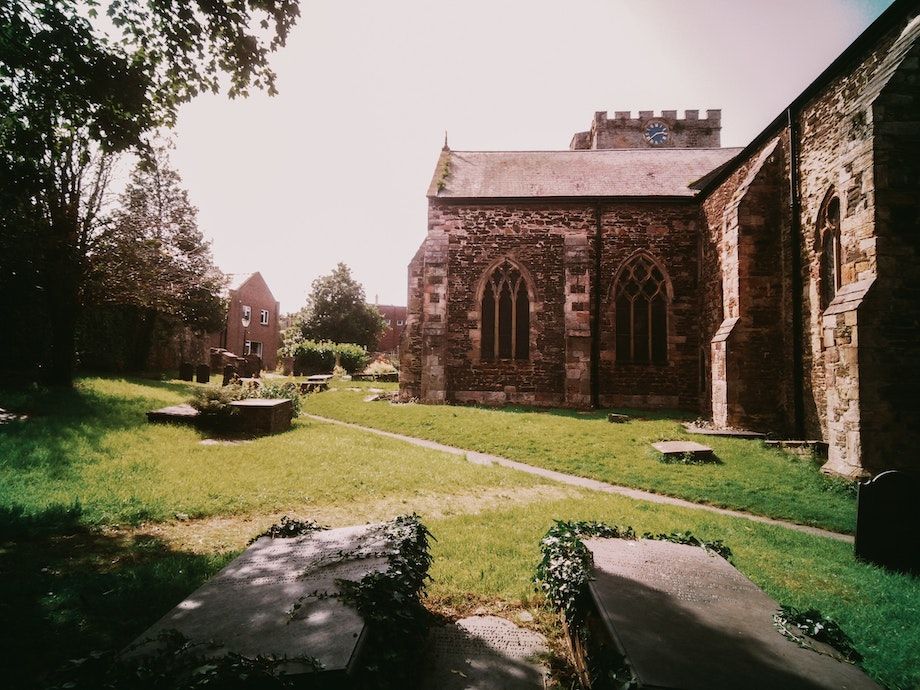Aimée Grant Cumberbatch explores the cemeteries full of life, and uncovers what these spaces can teach us about grief, bereavement, and our place in the world
Behind my house, there are dead people. Sounds creepy, right? Depending on your perspective, it is. My house backs on to a cemetery. To be fair, as cemeteries go, it’s not that creepy. Like others up and down the UK, it’s a haven for nature. In the spring and summer, wildflowers, like bird’s-foot-trefoil and common mallow, mingle with grasses, left to grow long. The sounds are the noisy squawks of parakeets, the cackling call of green woodpeckers, the shushing of those grasses or the hum of chatty crickets hiding within.
Not only can cemeteries provide crucial wildlife habitats in urban areas, and access to green spaces for the humans that live nearby, they are also uniquely contemplative spaces that promote wellbeing in a variety of ways. With awareness of the environmental impact of human death fuelling demand for eco-friendly burials, people are increasingly alive to the idea of cemeteries as spaces for far more than neat rows of graves and grass, only visited by mourners.
Three cemeteries that are wonderful examples of this are Ford Park Cemetery in Plymouth, Nunhead Cemetery in south London, and Arnos Vale Cemetery in Bristol. Their histories mirror those of many Victorian cemeteries, which became accidental wildlife refuges when their owners’ profits dried up.
During the early 1800s, churchyards, where burials traditionally took place, were becoming overcrowded and unsanitary. So from 1832 cemeteries, starting with London’s ‘Magnificent Seven’, were created around the country to provide new places for burials. In line with the Victorian experience of death as ever-present, thanks to high mortality rates especially among children, these cemeteries were conceived as spaces for the living and the dead.
For wealthy Victorians, they were also places to display financial power, leading to ornate tombs or statues atop graves. Families would come to visit graves, but also to picnic and admire trees or botanical specimens. Cemeteries were intended to be spaces of beauty, leisure, and learning, as well as mourning.
Once the cemeteries began filling up, the profits for the private companies that ran them dwindled, and many were eventually left to become overgrown and unkempt. At Nunhead, the period of neglect helped usher in wildlife, but for those charged with its maintenance in the 21st century, undoing some of its wildness is essential.
Friends of Nunhead Cemetery (FONC) co-ordinator Jeff Hart explains how the cemetery’s years of neglect saw ash and sycamore trees self-seed unchecked. Two of the commonest trees in the cemetery, they are not always the most useful for wildlife. Part of the efforts of FONC, who work to conserve the cemetery, is to cut back and thin out these species, giving ground to slower growing varieties like beech, oak, hornbeam, and birch.
It also allows for the creation of open spaces, ensuring the site has a diversity of habitat as well as trees, with areas of wetland, scrub, grassland, and even a hazel glade. These benefit a host of different wildlife, including 120 species of funghi, 60 species of bird, and 207 types of insect – one of which has never been recorded anywhere else.

There are benefits for human visitors, too – FONC keeps a section of the cemetery clear of tall trees to ensure the view across to St Paul’s Cathedral is preserved. The different areas provide interest, and FONC also includes botanical specimens that recall the common Victorian planting style.
Striking a balance between the cemetery’s present and its past, and its visitors – human and non-human – is a key theme in the management of all three cemeteries. This includes balancing the sometimes conflicting expectations of what a cemetery should look like. One person’s unmown, wildlife-friendly grass is another’s unkempt and seemingly unmanaged space.
At all three cemeteries, there are efforts to usher visitors and mourners into the journey of managing wildlife. Arnos Vale uses signage to explain its work, and will create a mown path for anyone wishing to visit a grave in the cemetery’s meadow-cut areas of longer grass. It’s important visitors know any seeming untidiness is by design, and serves a purpose.
Arnos Vale and Ford Park are active cemeteries, and offer plots in more traditionally-managed areas – think close-cut grass and neat rows of headstones. But they also have wilder burial areas. Here, mourners bury their loved one in a coffin that won’t harm the environment as it biodegrades, and, instead of headstones, might lay a small wooden plaque or plant a native tree like hawthorn – beloved by butterflies and moths. This opportunity to situate death within wild spaces can offer the chance to view it as part of something bigger, part of the circle of life.
But even for those who aren’t mourning, visits to cemeteries which are actively managed as spaces of both life and death present opportunities to adapt our relationship with mortality in helpful ways. Or at least just open up the subject to conversation, and thereby make it less taboo.
Janine Marriott, public engagement manager at Arnos Vale cemetery says: “A cemetery feels like a very natural space to talk about [these things]. There’s a lot of evidence to suggest that if you are comfortable talking about your own death and also make your relatives aware of your end-of-life choices, it makes your passing easier for everyone. People can be a bit superstitious, but talking about death definitely doesn’t kill you.”

Janine also notes the tranquillity of cemeteries is key. “At night, you get a lot fewer people using a cemetery [than a park]. So badgers and foxes can roam freely without being disturbed. Also, most historic cemeteries were built before the age of electricity. That means there’s very little light on site. They are great dark spaces for wildlife.” This tranquillity is good for humans, too: “They’re quite contemplative spaces. Unlike a park, you haven’t generally got people kicking a football around,” says Janine.
What can make cemeteries an especially vital wellbeing resource is their accessibility. Ford Park, Arnos Vale, and Nunhead are all located in urban areas, offering a green space for those living nearby. Like other green spaces, they can also help improve air quality, but may be especially effective as they often contain many mature trees. These have been found to clean air more efficiently than younger ones. Janine explains that Arnos Vale is located between the A37 and the A4, so the cemetery “is a really important part of the green lungs”. Even if nearby residents never visit a cemetery, they’ll still get a health and wellbeing boost.
But if they do visit, the wellbeing benefits are manifold. These cemeteries are often sweeping spaces – Nunhead is 52 acres, Arnos Vale is 45, and Ford Park is 32.5. But even when small, like the cemetery behind my house, they are places in which to lose yourself, whether in the stories that the gravestones tell, the architectural details of another time, the buzz of pollinating insects around wildflowers, the sunlight through leaves and branches, or even just in the atmosphere of these unique spaces.


Comments